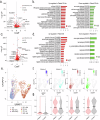Aberrant pace of cortical neuron development in brain organoids from patients with 22q11.2 deletion syndrome-associated schizophrenia
- PMID: 40750773
- PMCID: PMC12316906
- DOI: 10.1038/s41467-025-62187-x
Aberrant pace of cortical neuron development in brain organoids from patients with 22q11.2 deletion syndrome-associated schizophrenia
Abstract
Children and adults with 22q11.2 deletion syndrome (22q11.2DS) experience cognitive and emotional challenges and face a markedly increased risk for schizophrenia (SCZ), yet how this deletion alters early human brain development remains unclear. Using cerebral cortex organoids derived from individuals with 22q11.2DS and SCZ, we identify cell-type-specific developmental abnormalities. Single-cell RNA sequencing and experimental validation reveal delayed cortical neuron maturation, with increased neural progenitor proliferation and a reduced proportion of more mature neurons. We observe disrupted molecular programs linked to neuronal maturation, sparser neurites, and blunted glutamate-induced Ca²⁺ responses. The aberrant transcriptional profile is enriched for neuropsychiatric risk genes. MicroRNA profiling suggests that DGCR8 haploinsufficiency contributes to these effects via dysregulation of genes that control the pace of maturation. Protein-protein interaction network analysis highlights complementary roles for additional deleted genes. Our study reveals consistent developmental and molecular defects caused by 22q11.2 deletions, offering insights into disease mechanisms and therapeutic strategies.
© 2025. The Author(s).
Conflict of interest statement
Competing interests: The authors declare no competing interests.
Figures







Update of
-
Aberrant pace of cortical neuron development in brain organoids from patients with 22q11.2 deletion syndrome-associated schizophrenia.bioRxiv [Preprint]. 2025 Apr 24:2023.10.04.557612. doi: 10.1101/2023.10.04.557612. bioRxiv. 2025. Update in: Nat Commun. 2025 Aug 1;16(1):6986. doi: 10.1038/s41467-025-62187-x. PMID: 37873382 Free PMC article. Updated. Preprint.
References
-
- Shprintzen, R. J. et al. Velo-cardio-facial syndrome. Curr. Opin. Pediatr.17, 725–730 (2005). - PubMed
-
- Robin, N. H. & Shprintzen, R. J. Defining the clinical spectrum of deletion 22q11.2. J. Pediatr.147, 90–96 (2005). - PubMed
-
- Kobrynski, L. J. & Sullivan, K. E. Velocardiofacial syndrome, DiGeorge syndrome: the chromosome 22q11.2 deletion syndromes. Lancet370, 1443–1452 (2007). - PubMed
-
- Botto, L. D. et al. A population-based study of the 22q11.2 deletion: phenotype, incidence, and contribution to major birth defects in the population. Pediatrics112, 101–107 (2003). - PubMed
MeSH terms
Substances
Grants and funding
- R21 MH087840/MH/NIMH NIH HHS/United States
- R01 MH097879/MH/NIMH NIH HHS/United States
- R33 MH087840/MH/NIMH NIH HHS/United States
- 2R01MH097879/U.S. Department of Health & Human Services | NIH | National Institute of Mental Health (NIMH)
- UG3/UH3TR002151/U.S. Department of Health & Human Services | NIH | National Center for Advancing Translational Sciences (NCATS)
LinkOut - more resources
Full Text Sources
Medical
Miscellaneous

